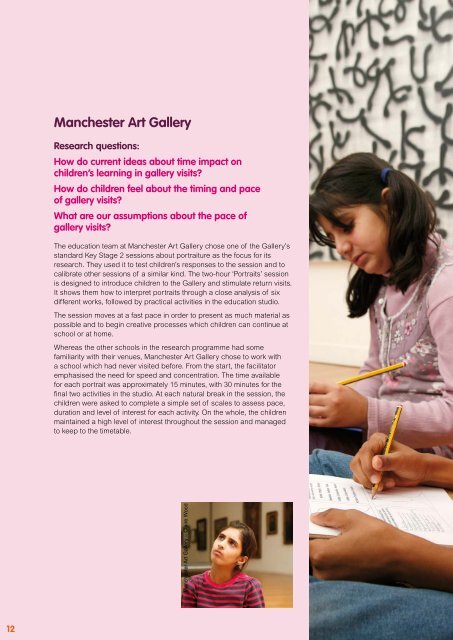Children-as-Co-researchers-in-the-design-of-museum-and-gallery-learning
Children-as-Co-researchers-in-the-design-of-museum-and-gallery-learning
Children-as-Co-researchers-in-the-design-of-museum-and-gallery-learning
Create successful ePaper yourself
Turn your PDF publications into a flip-book with our unique Google optimized e-Paper software.
Manchester Art Gallery<br />
Research questions:<br />
How do current ide<strong>as</strong> about time impact on<br />
children’s learn<strong>in</strong>g <strong>in</strong> <strong>gallery</strong> visits?<br />
How do children feel about <strong>the</strong> tim<strong>in</strong>g <strong>and</strong> pace<br />
<strong>of</strong> <strong>gallery</strong> visits?<br />
What are our <strong>as</strong>sumptions about <strong>the</strong> pace <strong>of</strong><br />
<strong>gallery</strong> visits?<br />
The education team at Manchester Art Gallery chose one <strong>of</strong> <strong>the</strong> Gallery’s<br />
st<strong>and</strong>ard Key Stage 2 sessions about portraiture <strong>as</strong> <strong>the</strong> focus for its<br />
research. They used it to test children’s responses to <strong>the</strong> session <strong>and</strong> to<br />
calibrate o<strong>the</strong>r sessions <strong>of</strong> a similar k<strong>in</strong>d. The two-hour ‘Portraits’ session<br />
is <strong>design</strong>ed to <strong>in</strong>troduce children to <strong>the</strong> Gallery <strong>and</strong> stimulate return visits.<br />
It shows <strong>the</strong>m how to <strong>in</strong>terpret portraits through a close analysis <strong>of</strong> six<br />
different works, followed by practical activities <strong>in</strong> <strong>the</strong> education studio.<br />
The session moves at a f<strong>as</strong>t pace <strong>in</strong> order to present <strong>as</strong> much material <strong>as</strong><br />
possible <strong>and</strong> to beg<strong>in</strong> creative processes which children can cont<strong>in</strong>ue at<br />
school or at home.<br />
Where<strong>as</strong> <strong>the</strong> o<strong>the</strong>r schools <strong>in</strong> <strong>the</strong> research programme had some<br />
familiarity with <strong>the</strong>ir venues, Manchester Art Gallery chose to work with<br />
a school which had never visited before. From <strong>the</strong> start, <strong>the</strong> facilitator<br />
emph<strong>as</strong>ised <strong>the</strong> need for speed <strong>and</strong> concentration. The time available<br />
for each portrait w<strong>as</strong> approximately 15 m<strong>in</strong>utes, with 30 m<strong>in</strong>utes for <strong>the</strong><br />
fi nal two activities <strong>in</strong> <strong>the</strong> studio. At each natural break <strong>in</strong> <strong>the</strong> session, <strong>the</strong><br />
children were <strong>as</strong>ked to complete a simple set <strong>of</strong> scales to <strong>as</strong>sess pace,<br />
duration <strong>and</strong> level <strong>of</strong> <strong>in</strong>terest for each activity. On <strong>the</strong> whole, <strong>the</strong> children<br />
ma<strong>in</strong>ta<strong>in</strong>ed a high level <strong>of</strong> <strong>in</strong>terest throughout <strong>the</strong> session <strong>and</strong> managed<br />
to keep to <strong>the</strong> timetable.<br />
Manchester Art Gallery – Claire Wood<br />
12


